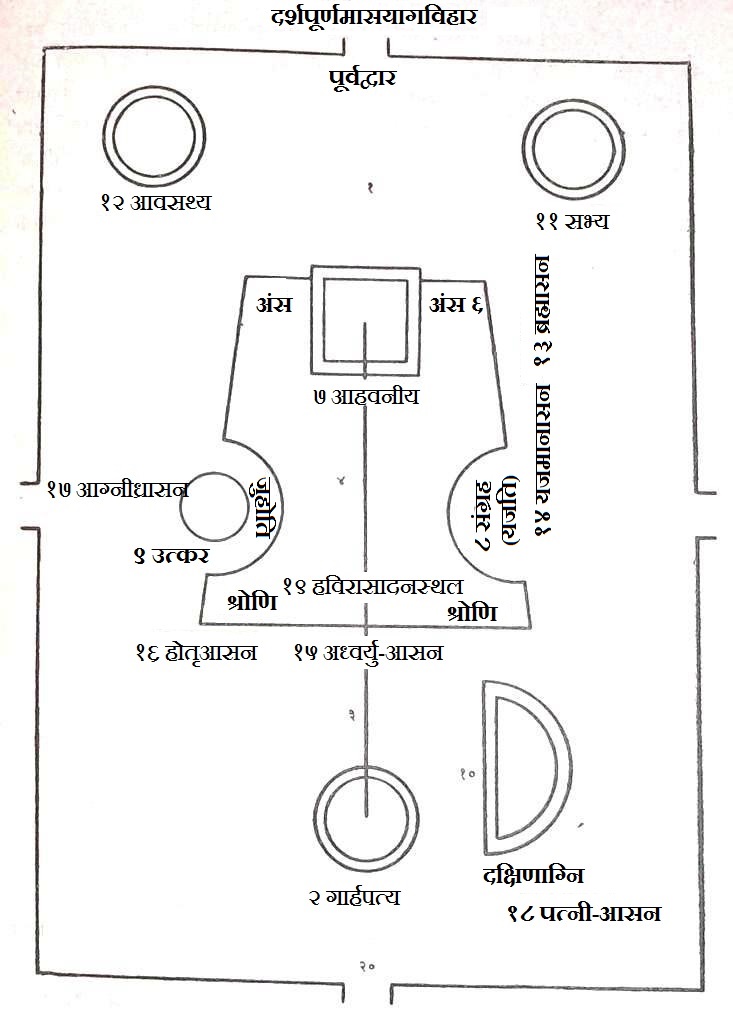|
Yajurveda
The ''Yajurveda'' ( sa, यजुर्वेद, ', from ' meaning "worship", and ''veda'' meaning "knowledge") is the Veda primarily of prose mantras for worship rituals.Michael Witzel (2003), "Vedas and Upaniṣads", in ''The Blackwell Companion to Hinduism'' (Editor: Gavin Flood), Blackwell, , pages 76-77 An ancient Vedic Sanskrit text, it is a compilation of ritual-offering formulas that were said by a priest while an individual performed ritual actions such as those before the yajna fire. Yajurveda is one of the four Vedas, and one of the scriptures of Hinduism. The exact century of Yajurveda's composition is unknown, and estimated by Witzel to be between 1200 and 800 BCE, contemporaneous with Samaveda and Atharvaveda. The Yajurveda is broadly grouped into two – the "black" or "dark" (''Krishna'') Yajurveda and the "white" or "bright" (''Shukla'') Yajurveda. The term "black" implies "the un-arranged, unclear, motley collection" of verses in Yajurveda, in contrast to ... [...More Info...] [...Related Items...] OR: [Wikipedia] [Google] [Baidu] |
Vedas
upright=1.2, The Vedas are ancient Sanskrit texts of Hinduism. Above: A page from the '' Atharvaveda''. The Vedas (, , ) are a large body of religious texts originating in ancient India. Composed in Vedic Sanskrit, the texts constitute the oldest layer of Sanskrit literature and the oldest scriptures of Hinduism. There are four Vedas: the Rigveda, the Yajurveda, the Samaveda and the Atharvaveda. Each Veda has four subdivisions – the Samhitas ( mantras and benedictions), the Aranyakas (text on rituals, ceremonies, sacrifices and symbolic-sacrifices), the Brahmanas (commentaries on rituals, ceremonies and sacrifices), and the Upanishads (texts discussing meditation, philosophy and spiritual knowledge).Gavin Flood (1996), ''An Introduction to Hinduism'', Cambridge University Press, , pp. 35–39A Bhattacharya (2006), ''Hindu Dharma: Introduction to Scriptures and Theology'', , pp. 8–14; George M. Williams (2003), Handbook of Hindu Mythology, Oxford University Pres ... [...More Info...] [...Related Items...] OR: [Wikipedia] [Google] [Baidu] |
Brahmana
The Brahmanas (; Sanskrit: , ''Brāhmaṇam'') are Vedic śruti works attached to the Samhitas (hymns and mantras) of the Rig, Sama, Yajur, and Atharva Vedas. They are a secondary layer or classification of Sanskrit texts embedded within each Veda, which explain and instruct on the performance of Vedic rituals (in which the related Samhitas are recited). In addition to explaining the symbolism and meaning of the Samhitas, Brahmana literature also expounds scientific knowledge of the Vedic Period, including observational astronomy and, particularly in relation to altar construction, geometry. Divergent in nature, some Brahmanas also contain mystical and philosophical material that constitutes Aranyakas and Upanishads. Each Veda has one or more of its own Brahmanas, and each Brahmana is generally associated with a particular Shakha or Vedic school. Less than twenty Brahmanas are currently extant, as most have been lost or destroyed. Dating of the final codification of the '' ... [...More Info...] [...Related Items...] OR: [Wikipedia] [Google] [Baidu] |
Isha Upanishad
The ''Isha Upanishad'' (Devanagari: ईशोपनिषद् IAST ') is one of the shortest Upanishads, embedded as the final chapter (''adhyāya'') of the Shukla Yajurveda. It is a ''Mukhya'' (primary, principal) Upanishad, and is known in two recensions, called Kanva (VSK) and Madhyandina (VSM). The Upanishad is a brief poem, consisting of 17 or 18 verses, depending on the recension. It is a key scripture of the Vedanta sub-schools, and an influential Śruti to diverse schools of Hinduism. It is the 40th chapter of Yajurveda. The name of the text derives from its incipit, ', "enveloped by the Lord",Ralph T. H. Griffith''The Texts of the White Yajurveda'' pages 304-308 or "hidden in the Lord (Self)".Max Muller, ''The Upanishads, The Sacred Books of the East'', Part 1, Oxford University Press, Reprinted by Routledge in 2013, , Vol. 1, pages 311-319 The text discusses the Atman (Self) theory of Hinduism, and is referenced by both Dvaita (dualism) and Advaita (non-dualism) ... [...More Info...] [...Related Items...] OR: [Wikipedia] [Google] [Baidu] |
Yajna
Yajna ( sa, यज्ञ, yajña, translit-std=IAST, sacrifice, devotion, worship, offering) refers in Hinduism to any ritual done in front of a sacred fire, often with mantras.SG Nigal (1986), Axiological Approach to the Vedas, Northern Book, , pages 80–81 Yajna has been a Vedic tradition, described in a layer of Vedic literature called Brahmanas, as well as Yajurveda. The tradition has evolved from offering oblations and libations into sacred fire to symbolic offerings in the presence of sacred fire ( Agni). Yajna rituals-related texts have been called the ''Karma-kanda'' (ritual works) portion of the Vedic literature, in contrast to ''Jnana-kanda'' (knowledge) portion contained in the Vedic Upanishads. The proper completion of Yajna-like rituals was the focus of Mimansa school of Hindu philosophy. Yajna have continued to play a central role in a Hindu's rites of passage, such as weddings. Modern major Hindu temple ceremonies, Hindu community celebrations, or monastic in ... [...More Info...] [...Related Items...] OR: [Wikipedia] [Google] [Baidu] |
Brihadaranyaka Upanishad
The ''Brihadaranyaka Upanishad'' ( sa, बृहदारण्यक उपनिषद्, ) is one of the Principal Upanishads and one of the first Upanishadic scriptures of Hinduism. A key scripture to various schools of Hinduism, the ''Brihadaranyaka Upanisad'' is tenth in the Muktikā or "canon of 108 Upanishads". The ''Brihadaranyaka Upanishad'' is estimated to have been composed about 7th-6th century BCE, excluding some parts estimated to have been composed after the '' Chandogya Upanishad''. The Sanskrit language text is contained within the ''Shatapatha Brahmana'', which is itself a part of the Shukla Yajur Veda. The ''Brihadaranyaka Upanishad'' is a treatise on Ātman (Self), includes passages on metaphysics, ethics and a yearning for knowledge that influenced various Indian religions, ancient and medieval scholars, and attracted secondary works such as those by Adi Shankara and Madhvacharya. Chronology The chronology of ''Brihadaranyaka Upanishad'', like other ... [...More Info...] [...Related Items...] OR: [Wikipedia] [Google] [Baidu] |
Katha Upanishad
The ''Katha Upanishad'' (Sanskrit: कठोपनिषद् or कठ उपनिषद्) (') is one of the ''mukhya'' (primary) Upanishads, embedded in the last eight short sections of the ' school of the Krishna Yajurveda.Paul Deussen. ''Sixty Upanishads of the Veda''. Volume 1, Motilal Banarsidass. . pages 269-273 It is also known as ' Upanishad, and is listed as number 3 in the Muktika canon of 108 Upanishads. The Katha Upanishad consists of two chapters (''Adhyāyas''), each divided into three sections (''Vallis''). The first ''Adhyaya'' is considered to be of older origin than the second. The Upanishad is the legendary story of a little boy, Nachiketa – the son of Sage Vajasravasa, who meets Yama (the deity of death). Their conversation evolves to a discussion of the nature of man, knowledge, Atman (Self) and moksha (liberation). The chronology of Katha Upanishad is unclear and contested, but belongs to the later verse Upanishads, dated to the 5th to first centur ... [...More Info...] [...Related Items...] OR: [Wikipedia] [Google] [Baidu] |
Maitri Upanishad
The ''Maitrayaniya Upanishad'' ( sa, मैत्रायणीय उपनिषद्, ) is an ancient Sanskrit text that is embedded inside the Yajurveda.Paul Deussen, Sixty Upanishads of the Veda, Volume 1, Motilal Banarsidass, , pages 327-386 It is also known as the ''Maitri Upanishad'' ( sa, मैत्री उपनिषद्, ), and is listed as number 24 in the Muktika canon of 108 Upanishads. The ''Maitrayaniya Upanishad'' is associated with the ''Maitrayanas'' school of the Yajurveda. It is a part of the "black" Yajurveda, with the term "black" implying "the un-arranged, motley collection" of content in Yajurveda, in contrast to the "white" (well arranged) Yajurveda where Brihadaranyaka Upanishad and Isha Upanishad are embedded.Paul Deussen, Sixty Upanishads of the Veda, Volume 1, Motilal Banarsidass, , pages 217-219 The chronology of Maitrayaniya Upanishad is contested, but generally accepted to be a late period Upanishadic composition.Stephen Phillips (2009 ... [...More Info...] [...Related Items...] OR: [Wikipedia] [Google] [Baidu] |
Satapatha Brahmana
The Shatapatha Brahmana ( sa, शतपथब्राह्मणम् , Śatapatha Brāhmaṇam, meaning 'Brāhmaṇa of one hundred paths', abbreviated to 'SB') is a commentary on the Śukla (white) Yajurveda. It is attributed to the Vedic sage Yajnavalkya. Described as the most complete, systematic, and important of the Brahmanas (commentaries on the Vedas), it contains detailed explanations of Vedic sacrificial rituals, symbolism, and mythology. Particularly in its description of sacrificial rituals (including construction of complex fire-altars), the Shatapatha Brahmana (SB) provides scientific knowledge of geometry (e.g. calculations of pi and the root of the Pythagorean theorem) and observational astronomy (e.g. planetary distances and the assertion that the Earth is circular) from the Vedic period. The Shatapatha Brahmana is also considered to be significant in the development of Vaishnavism as the origin of several Puranic legends and avatars of the RigVedic god Vi ... [...More Info...] [...Related Items...] OR: [Wikipedia] [Google] [Baidu] |
Atharvaveda
The Atharva Veda (, ' from ' and ''veda'', meaning "knowledge") is the "knowledge storehouse of ''atharvāṇas'', the procedures for everyday life".Laurie Patton (2004), Veda and Upanishad, in ''The Hindu World'' (Editors: Sushil Mittal and Gene Thursby), Routledge, , page 38 The text is the fourth Vedas, Veda, and is a late addition to the Vedic scriptures of Hinduism.Laurie Patton (1994), Authority, Anxiety, and Canon: ys in Vedic Interpretation, State University of New York Press, , page 57 The language of the Atharvaveda is different from Vedic Sanskrit, preserving pre-Vedic Indo-European archaisms. It is a collection of 730 Music of India#History, hymns with about 6,000 mantras, divided into 20 books.Maurice BloomfieldThe Atharvaveda Harvard University Press, pages 1-2 About a sixth of the Atharvaveda texts adapts verses from the Rigveda, and except for Books 15 and 16, the text is mainly in verse deploying a diversity of Vedic meters. Two different recensions of the text ... [...More Info...] [...Related Items...] OR: [Wikipedia] [Google] [Baidu] |
Shvetashvatara Upanishad
The ''Shvetashvatara Upanishad'' ( sa, श्वेताश्वतरोपनिषद् or or , IAST: ' or ') is an ancient Sanskrit text embedded in the Yajurveda. It is listed as number 14 in the Muktika canon of 108 Upanishads. The Upanishad contains 113 mantras or verses in six chapters.Robert Hume (1921)Shvetashvatara Upanishad The Thirteen Principal Upanishads, Oxford University Press, pages 394–411 with footnotes The Upanishad is one of the 33 Upanishads from Taittiriyas, and associated with the ''Shvetashvatara'' tradition within ''Karakas sakha'' of the Yajurveda. It is a part of the "black" "krishna" Yajurveda, with the term "black" implying "the un-arranged, motley collection" of content in Yajurveda, in contrast to the "white" (well arranged) Yajurveda where Brihadaranyaka Upanishad and Isha Upanishad are embedded. The chronology of Shvetashvatara Upanishad is contested, but generally accepted to be a late period Upanishadic composition.Stephen Phillips (200 ... [...More Info...] [...Related Items...] OR: [Wikipedia] [Google] [Baidu] |
Taittiriya Upanishad
The Taittirīya Upanishad (Devanagari: तैत्तिरीय उपनिषद्) is a Vedic era Sanskrit text, embedded as three chapters (''adhyāya'') of the Yajurveda. It is a '' mukhya'' (primary, principal) Upanishad, and likely composed about 6th century BC. The Taittirīya Upanishad is associated with the Taittirīya school of the Yajurveda, attributed to the pupils of sage Vaishampayana. It lists as number 7 in the Muktika canon of 108 Upanishads. The Taittirīya Upanishad is the seventh, eighth and ninth chapters of ''Taittirīya Āraṇyaka'', which are also called, respectively, the ''Śikṣāvallī'', the ''Ānandavallī'' and the ''Bhṛguvallī''. This Upanishad is classified as part of the "black" Yajurveda, with the term "black" implying "the un-arranged, motley collection" of verses in Yajurveda, in contrast to the "white" (well arranged) Yajurveda where ''Brihadaranyaka Upanishad'' and ''Isha Upanishad'' are embedded. Paul Deussen, Sixty Upanishads ... [...More Info...] [...Related Items...] OR: [Wikipedia] [Google] [Baidu] |
Yajnavalkya
Yajnavalkya or Yagyavalkya ( sa, याज्ञवल्क्य, ) is a Hindu Vedic sage figuring in the Brihadaranyaka Upanishad (c. 700 BCE)., Quote: "Yajnavalkya, a Vedic sage, taught..."Ben-Ami Scharfstein (1998), ''A comparative history of world philosophy: from the Upanishads to Kant'', Albany: State University of New York Press, pp. 9-11 Yajnavalkya proposes and debates metaphysical questions about the nature of existence, consciousness and impermanence, and expounds the epistemic doctrine of neti neti ("not this, not this") to discover the universal Self and Ātman. Texts attributed to him include the '' Yajnavalkya Smriti'', '' Yoga Yajnavalkya'' and some texts of the Vedanta school. He is also mentioned in Brahma puran and various Brahmanas and Aranyakas. Setting The ''Brihadaranyaka Upanishad'' is dated at c. 700 BCE,. Staal notes that though the name Yajnavalkya is derived from ''yajna'', which connotes ritual, Yajnavalkya is referred to as "a thinker, not a ... [...More Info...] [...Related Items...] OR: [Wikipedia] [Google] [Baidu] |












